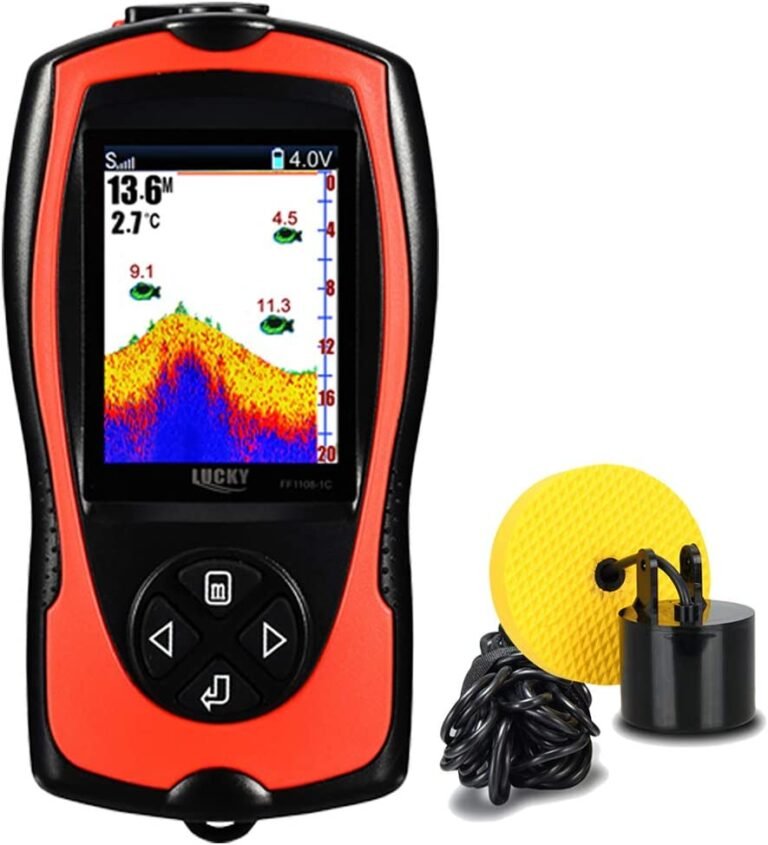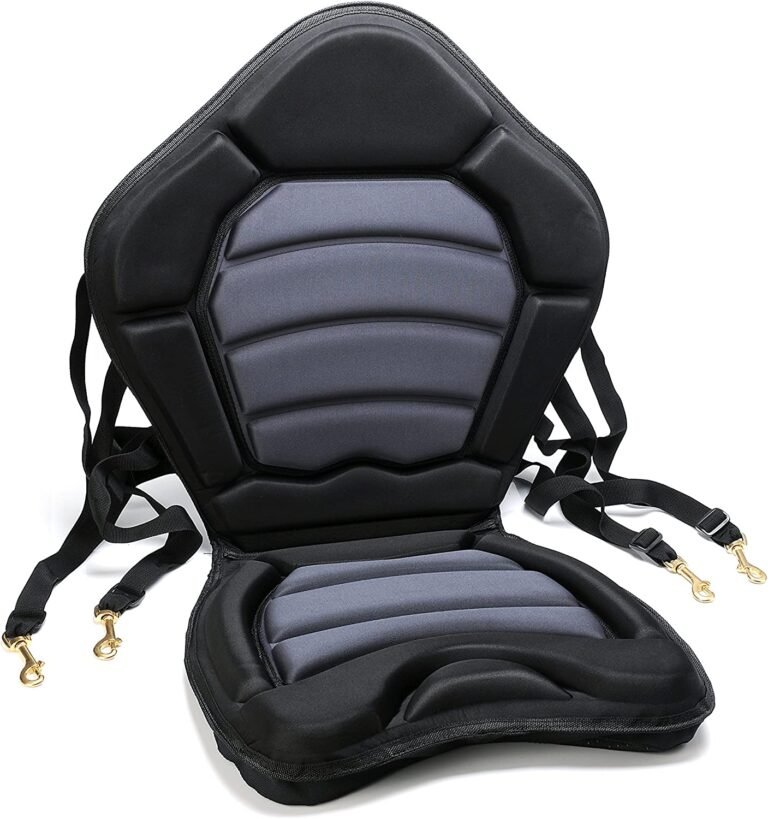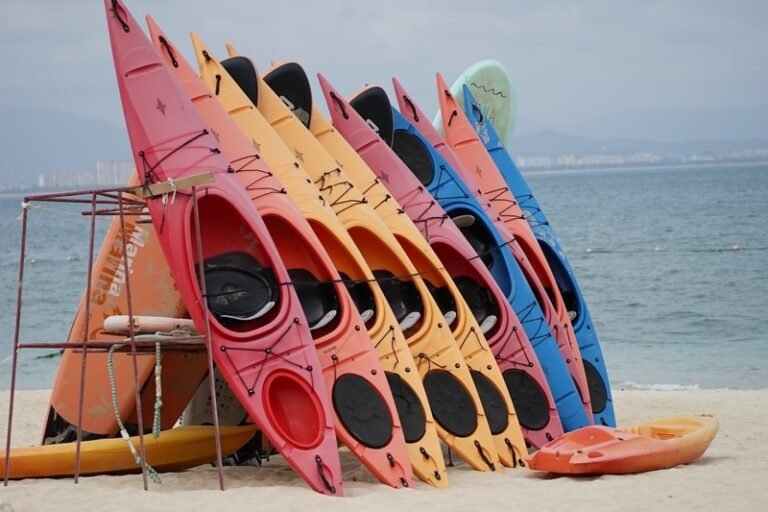10 Best Kayak Roof Racks To Buy In 2024
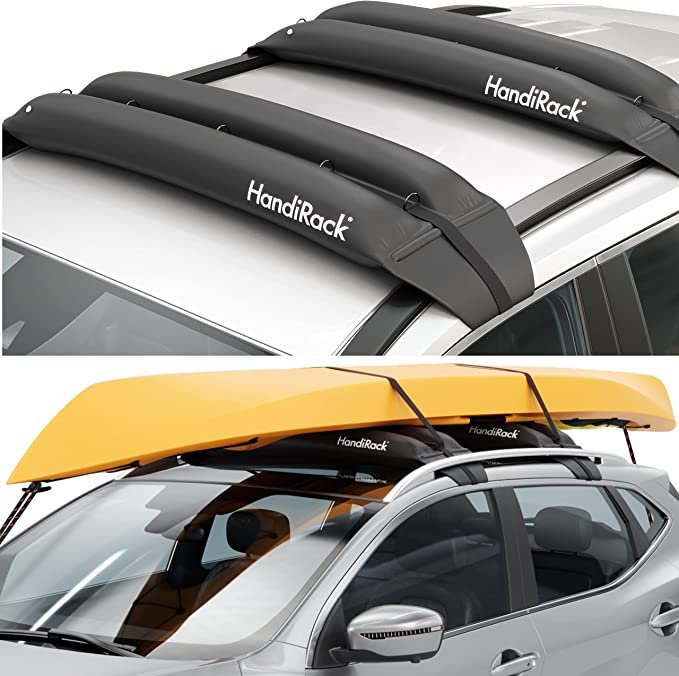
Do You Need A Roof Rack For Your Kayaks?
When it comes to kayaking and other water sports, whether as a starter or a professional, the act of paddling across a lake or down a river is only half the battle.
Transporting your kayak and gear to a water source or campsite miles away without your ride or watercraft scratched or dangling is one of the kayaking challenges every kayaker needs to solve.
If you’re relatively new to kayaking, a high-quality roof rack system is a mandatory accessory that you need to own. Luckily, the market is full of many affordable roof-mounting solutions with different styles and designs and some are even made to carry multiple boats.
Choosing the right kayak roof rack for your unique setup will require careful consideration. So, before your next kayaking trip, read on for our top kayak rack recommendations, plus some important criteria to help you select a roof rack that’s right for you, your vehicle, and your paddling preferences.
Our Top 10 Kayak Roof Rack Picks
1. TMS J-Bar Rack HD Kayak Carrier
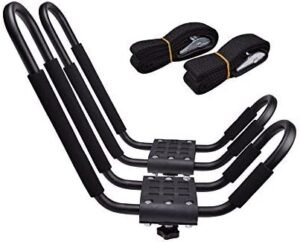
The inexpensive strength and security make the J-bar one of the most popular kayak carrier options out there and included in the TMS set are two of these mounts.
Owing to its different lengths of bolts, TMS J-Bar HD Rack is designed to work with any kind of existing crossbars and supports a boat up to 75 pounds and 36 inches wide.
The bars are made of hollow steel and with some adjustable foam padding, the sensitive areas of your kayak are protected while you’re in transit.
Though this roof rack comes with accessories only for a single kayak, there is enough room space for two additional J-bars and a second kayak provided the roof is large and strong enough.
The TMS J-Bar Rack HD can be permanently installed on your vehicle’s crossbars, but since it doesn’t have a folding capacity, it could have an adverse impact on your fuel economy and aerodynamics.
Pros
- Compact rack system
- Easy load and unload
- Fast removal and installation
- Adjustable size
- Fits kinds of all crossbars
- Great value for the price
- Doesn’t require any additional tools
- Sturdy steel construction
- Can accommodate another set for two kayaks
Cons
- Felt a bit shaky
- Relatively low weight capacity
- Not a low-profile design
2. Handirack Universal Inflatable Roof Rack Bars
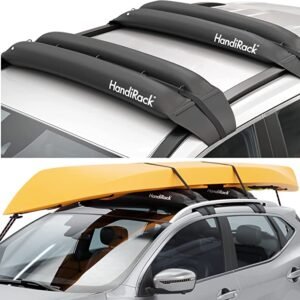
Handirack roof rack pads are inflatable roof rack that is designed for mounting watercraft and other equipment on top of vehicles.
No mounting hardware, crossbar, roof rails, or additional accessories are required for its installation; instead, it acts as a temporary crossbar and cushioned pad in one. They are compatible with all kinds of vehicles except for those that have sliding doors (because that’s where you attach them).
The four ratchet straps are used to secure the kayak’s front, rear, and center while the cushions are fixed to the roof by lashing through the interior. When not in use, it takes up a minimal amount of space in your trunk.
This unique kayak carrier comes with all you need to securely hold your vessel at the top of the vehicle and can also be used to transport the vessel’s gear.
Included in this package are tie-down straps, buckles, a travel bag for easy storage, a stern tie-down line for extra security, and a hand pump for easy inflation of the rubber chambers held by the set’s nylon outer layers.
The Handirack roof rack pads are perfect for smaller sedans, station wagons, and SUVs and can pride themselves on quite a high load capacity of 175 lb as well as supporting cargo up to 38 inches wide.
Just ensure you let out some air because the cushion may become over-inflated in the hot sun if the temperature rises.
Pros
- Universal design
- Concise and clear instructions
- Well-secured straps
- Doesn’t require side rails
- Comes with a travel bag
- Compact and easy to store
- No tools or drilling required
- Impressive 175-pound load capacity
- When in use, there is minimal drag and wind noise
Cons
- Less durable than steel racks
- it can’t be installed permanently on the vehicle
3. IKURAM Folding Rack

Are you in search of a dual J-style rack with a two-kayak capacity? Look no more than IKURAM folding rack.
Built with aviation-grade aluminum alloy, this rack offers you best-in-its-class top arm padding protection and ensures that your kayak is kept from being dented or damaged while in transit.
The included straps properly secure your kayak on your smaller SUVs and sedans as well as save you space for other kayaking gear in your trunk.
IKURAM folding rack supports a boat up to 150 pounds and is 43 inches wide. When actively not in use, this dual J-style rack folds down with less or no impact on your vehicle’s fuel economy.
Pros
- Well-secured straps
- Fold down when not in use
- Sturdy steel frame
- Easy to install and use
- Sturdy and dependable for a good price
Cons
- Not a universal mounting design
4. Leader Accessories Folding Rack
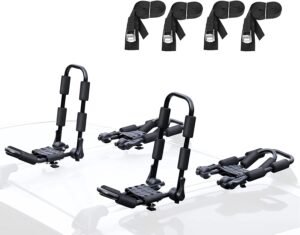
These two-pack folding J-style racks require your vehicle to have existing crossbars for a secure installation. Apart from round bars, the Leader Accessories folding rack fits on factory-installed oval, square bars, and aerodynamic bars.
This kayak carrier features a quick-release button that allows you to set them up for kayak transporting with a simple lever or fold them down. Also, it comes with a total of four cam-style tie-down straps to help you secure your kayaks with ease.
The Leader Accessories folding racks are built with powder-coated steel to minimize rust and corrosion over their lifetime and each rack holds a load capacity of 100 pounds.
They have a folding ability that allows you to install them permanently on your vehicle’s roof whether you’re transporting kayaks or not.
Pros
- Very easy to use and install.
- powder-coated steel prevents rust and corrosion
- Fold down when not in use
- 4 cam-style tie-down straps included
Cons
- There’s a need to tighten the locking mechanism from time to time due to its sketchy nature
- The mounting hardware is short
- It won’t work with round bars
5. WOOWAVE Roof Rack Pads

WOOWAVE Roof Rack Pads are the perfect choice for outdoor activities. The soft roof rack pads have a universal design that fits nearly every vehicle and is used in all weather conditions.
Included in this roof rack are 2 waterproof polyester tie-down straps with padded metal buckle that offers high performance for outdoor applications in terms of break strength, UV resistance, water resistance, and abrasion resistance as well as safely carrying the kayaks or surfboards to the beach, river, ocean, etc.
The WOOWAVE roof racks are made of grade EPE foam padded interior, UV-resistant ballistic nylon cover exterior, and bungee cord end straps. They’re also designed aerodynamically to protect your car and boards from scratches when secured to roof racks.
WOOWAVE Roof Rack Pads are easy to use and fit tightly around the cross bars on the car. The kit is lightweight and compact for easy storage and transportation. The included portable storage bag keeps them safe and secure when not in use.
This universal car roof carrier accommodates kayaks with widths up to 33 inches and supports a 110lb load capacity. Plus, a year warranty in case of any damage.
Pros
- Protects the car’s roof from scratches
- Easy installation and setup
- Temporary, budget-friendly solution
- A storage bag included
Cons
- Only two sets of straps to secure the yak are included
- The foam might not hold well over time
- The ideal solution for longer trips isn’t foam blocks
6. Yakima JayLow Rooftop Mounted Kayak Rack

The Yakima JayLow Kayak Rack is a top-notch rack that is easy to install on your vehicle without any additional tools needed.
Unlike many J-style racks, this carrier has a low-profile design that features a built-in cam lever and folds system that expands the clearance. So, this rack can remain on your crossbars even after use.
The tie-down straps secure the kayak, along with the safe oversized padding with nylon covers that protect your valuable boat.
Pros
- Very secure mounting hardware
- High-quality construction
- Large load capacity
- Versatile; fits most of the crossbars
- To adjust the position, a handy integrated cam lever is included
- Can carry two kayaks
Cons
- The standard roof rack is lightweight when compared
- Instructions aren’t precise
7. Malone Downloader Folding J-Style Universal Car Rack Kayak Carrier
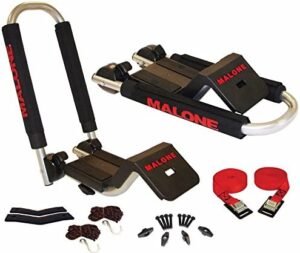
The Malone Downloader folding J-style kayak rack includes everything you need to carry a single kayak vertically on your rooftop.
The built-in loading ramps help for easy loading and unloading of kayaks while oversized padding helps protect the boat once strapped down during transportation.
The Malone universal JAWZ mounting hardware fits square, round, and factory oval cross rails. This rack can be installed permanently on your crossbars since it folds down when not in use.
The Malone Downloader offers a maximum load capacity of 75 pounds and features a set of cam-style straps and bow and stern tie lines to help properly secure your kayak.
Pros
- Stable and easy to install
- Easy to load and unload
- No additional hardware needed
- designed to fit various shapes of bars
- Coated bolts that reduce corrosion
- The racks are strong and offer excellent tie-down points.
Cons
- The carrier cannot be locked to the crossbars
8. Thule Hull-a-Port XT Rooftop Kayak Carrier
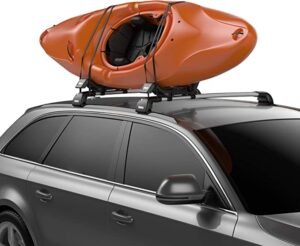
The Thule Hull-a-Port XT is one of the more versatile rack systems that have the capacity to safely transport 1-2 kayaks without including a StrapCatch on the top arm of the rack.
During the loading process, this catch makes it easier to set your straps in place with no worry of your kayak sliding or slipping off during transportation.
The Hull-a-Port XT also boasts a maximum load capacity of 75 pounds for a single boat and up to 130 pounds for two boats.
It’s designed to be installed on all types of load bars up to 80 mm in width and when not actively in use, it folds flat with no negative effect on your vehicle’s fuel economy.
Pros
- Foldable J-Style kayak carrier
- Carry bag included
- Sturdy and durable
- Steel design with adjustable padding
- Rust resistant
- Load straps included
- Easy loading
- Create more room on the load bar
Cons
- A bit pricey
9. Malone SeaWing Saddle Style Kayak Carrier

Malone SeaWing kayak rack is the most secure kayak carrier available. It is also, a great option if you need enough space for your life jacket, anchor, or paddles next to your kayak on the top of the roof.
Its low-profile design can hold a second system for carrying kayaks side-by-side. The ratcheting straps fasten it to the roof while the 2 adjustable V-shaped beds support the boat in a horizontal position.
The saddles gently flex to fit kayaks of many different widths which improves mileage and reduces wind drag. The saddle-style carriers are more stable than foam pads and J-cradles when there’s extra surface contact with the kayak.
The SeaWing’s bow-shaped design cradles a kayak gently, with a body made from flexible polycarbonate and rubber for protection.
Included in this rack is a Jawz mounting hardware that makes it compatible with most square, round, and oval cross rails. Also, this set features 2 handy integrated straps and 2 bungee cords to better secure the bow and stern.
Malone SeaWing boasts a maximum load capacity of 70 pounds with about 35 inches of cargo width. Smaller vehicles may only be able to mount one set of this carrier without clearance issues due to its wideness.
Pros
- The carefully utilized dynamic profile leaves a lot of space
- Corrosion-free frame
- Attractive design
- Its midpoint mounting can hold two kayaks Secure load straps
- Easy to install
- Holds cargo firmly but gently
Cons
- Low load capacity
- A bit pricey
- Not lockable and no security options are available
- Some assembly required
10. Thule 830 Stacker Kayak Rack Carrier Rack

Do you want to enjoy kayaking to the fullest with its carrying capabilities? Thule 830 Stacker Kayak Rack Carrier is an ideal choice. This great piece of hardware made it much easier to rest your kayak while you got everything strapped up.
The straps are secured in the Stacker by running them through the unit itself and not on hooks. The better choice of construction materials and oval shape of the Stacker made this easily the best multi-kayak car top system.
It folds away easily when not in use for higher clearance and can hold up to 4 recreational kayaks (depending on their size).
In addition, it features a fold-down steel design with a non-scratch outer coating and accommodates kayaks up to 36 inches wide and weighing 75 pounds.
Pros
- There’s enough space for additional gear
- Suitable for the whole family
- Steel construction with a non-scratch coating
- Great Weight Distribution on the product’s frame
- Hardly any noise when not in use
Cons
- No assist features
- It only includes two sets of accessories for securing the boats
- The rack lacks Hull Pads which avoid pressure pointing to the side of the Kayaks’ Hulls
Kayak Roof Rack Buying Guide
Don’t comb through the market aimlessly and arbitrarily if you intend to invest in a kayak rack. You’ll need to know what to look for to choose the right kayak rack for your specific needs.
The first step to take before you make that crucial decision is to get acquainted with all the types of kayak roof racks.
Rack Type
The market is full of various kayak rack types and designs. Below are the different types with their various pros and cons.
Folding J-Style Roof Racks
Folding roof racks are installed permanently on your factory crossbars even when you aren’t transporting your kayak.
They fold down when not in use and will not have a negative impact on your fuel economy. When you’re ready to load your kayak onto them, they’re also easy to flip up and secure.
J-Bar (or J-Style) Roof Racks
The only difference between J-style roof rack and their folding J-style counterparts is that they don’t just fold down or away when you’re not using them.
J-style roof racks are installed on an already existing vehicle factory crossbars on the roof but when permanently installed, they can impact your fuel economy when you’re not transporting a kayak.
Roof Rack Pads
Roof rack pads are mostly used on vehicles that don’t have factory crossbars installed on their roof. The included straps secure your kayak to your roof by strapping it through your cargo doors.
Many of these pads are made of foam while others are inflatable with a more compact space when you’re not using them. You don’t install these pads on top of vehicles permanently unless you’re ready to transport kayaks.
Cradle-Style Roof Racks
Cradle-style roof racks are also designed for vehicles that already have factory crossbars installed on the roof but they essentially sit at a 45-degree angle on your crossbars, allowing for an easy side-loading of the kayak.
Compared to lifting the kayak to the top, you’ll find that the sideways loading is a lot easier. While in transit, these racks are great for keeping your kayak from moving side-to-side.
You can also get away without using this style of rack if you properly strap your kayak down to flat factory crossbars.
T-Bar Roof Racks/Stackers
This style of roof rack is also sometimes known as a ‘stacker’ because they “stack” kayaks in an upright position (sit on their sides).
Most of these roof racks are designed to be permanently installed on factory crossbars and there will be more space on the top of your vehicle that can accommodate up to two or more kayaks.
Flat Bars/Truck Racks
Flat bars are racks that are designed to be installed on the top of small vehicles or SUVs while a truck rack is without question your best option for transporting more than one kayak, especially for those who are lucky enough to own a truck.
Truck racks are installed in the bed of a truck and are great for carrying longer kayaks because they allow the bow of the kayak to extend over the cab of the truck.
Truck Utility Rack is a combination of a roof rack system and truck bed rack, and this offers you the opportunity to get the best of both worlds.
Inflatable Roof Rack
Inflatable roof racks are temporarily attached to the doors and you don’t need to have mounting points on your car. They are easily packed when not in use and of course the most compact and cheapest, as well.
Are you the type that carries a kayak in a range of vehicles, and swaps between the cars often? This kind of rack is just for you.
Saddles (with Rollers)
Saddles are designed to have a bigger surface to put the kayak on. So compared to the other types, they offer an additional layer of security.
If they come with an assist roller system, then lifting your kayak yourself is not needed since it does the job and takes the weight off your kayak to load and unload it.
Kayak Capacity
Racks, roof rails, and carriers are also rated for varying levels of cargo capacity. So, in addition to deciding on the type of rack you prefer, another essential factor to consider is the kayak rack capacity.
This is necessary as some of these racks are designed to accommodate a single boat while others are designed to carry two or more.
Always keep it simple and ensure that the preferred kayak rack can carry and handle the weight of as many kayaks as you need to transport at once without compromising performance.
Keep in mind that despite having a single kayak, at some point there might be a need to carry more than one kayak at once if you have a paddle partner along on your adventures.
Ease of Installation
For starters, this factor depends on how often you plan to use your kayak racks once you’ve purchased them.
Some of these racks are designed to be installed permanently on top of your vehicle and just as expected, they come with an up-front installation process that’s a bit more difficult than others.
However, once it’s been installed, the worry of constantly reinstalling and removing the rack every time you need to transport your kayak is eliminated.
On the other hand, some racks are designed to secure safely on top of your vehicle only when you’re transporting kayaks and they’re much easier to install.
So, if for example, you intend to transport your kayaks multiple times per week or go long distances, you’ll probably want a rack style that is designed to be permanently installed.
While it might make more sense to have a style that’s easier to install and remove only when you’re ready to transport your kayaks if you intend to transport your kayaks a few times a year on camping trips or other kinds of extended outings or even a short distance at slower speeds.
Also, it is equally important to consider the roof’s size, shape, and design.
Kayak Loading Tips
Having standard cross bars that are up to the challenge and are rated for the weight of your kayak is the most important tool to having a successful time with a car topping a large sit-on-top kayak.
Assist roller is another tool that allows you to place the kayak’s bow onto the roller and then push the kayak onto the racks saving you the stress of lifting the kayak yourself.
However, ensure that whatever you choose has adequate load capacity and is tall enough to go over the back of your car.
Last but not least is a car doorstep. It is best if it is sturdy enough for your weight and wide enough to put both feet on it. All of these tools make car topping much easier.
Kayak Roof Rack Safety Tips
- Check whether the preferred rack and your vehicle are compatible and calculate the weight that you are going to add to the full construction. Ensure that the weight doesn’t exceed the maximum weight that your vehicle can carry safely without compromising performance.
- Check local laws and regulations and make sure that the roof rack meets safety standards.
- Always adhere to the rule that says ” more massive load on the bottom, lightweight on the top”. This rule is there to prevent any accidents and balance the weight. For example, load the kayak first, and then some accessories (e.g., paddles).
- Be aware of the height. A roof rack and kayak will no doubt add a lot of height to your vehicle. So in such a case, you need to carefully plan out where you will pass, as your clearance is limited. Always look out for the parking ramp ahead and the overpass.
- Other essential skills required are knowing how to load (kayak on and off the rack) and secure your kayak to a roof rack. You should equally know how to strap it correctly to avoid it slipping off.
- Have your Kayak on top of your car or truck covered to keep the wind out of the cockpit, as well as protect it from road debris.
- Double-checking— before getting on the road, double-check to know whether the racks are correctly placed.
Pros Of Having A Roof Rack On Your Car/Truck
Easy to Store, Fit and Remove
A Kayak roof rack is a transporting tool that is easy to store and while you can leave a kayak roof rack in place when not in use, it can be easily removed and reinstalled if you want to.
Roof Racks are Cheaper
Compared to most trailers, kayak roof racks are invariably cheaper. Also, the use of racks only requires having a roof crossbar and with the tie-down straps and j-bars, you are good to go.
No Modification needed
Other than roof bars which many cars have as standard, there’s no need for any modifications to use a kayak roof rack.
Having a kayak on your roof doesn’t affect your driving skill or the ability to reverse or maneuver. It only demands you to drive a little slower.
No additional attention and care is needed other than making sure your kayak roof rack is securely fastened to your vehicle.
Offers Better Space Facility
If you are embarking on a distance trip and need to carry a lot of stuff, the coolest and best way of storing your things is the use of roof racks. Roof Racks ensure no clog issues for comfortable usage with comfortable storage space.
Instead of packing your luggage in the car, the racks give riding ease for the whole family by carrying loads on top of the car. Kayak roof racks don’t take up much storage space when removed. Most of them only need an Allen key.
Gives Assurance Of Longevity
Most roof racks are made with durable materials like steel, aluminum, or quality polymers. Due to their good structure, they perform well and last for a long time.
Thanks to their matchless sturdiness, even under unsettling weather conditions, they stay strong without having crack or break issues. There’s also warranty protection against damages for up to 3-4 years in the roof racks that are used on trucks.
Effortless to Carry Items
Another big plus point of roof racks is their ability to hold up to 165 lbs in good space management. Almost all modern roof racks are portable and slim that don’t feel hard to carry either. Thanks to their nice outline and setups, you can pretty easily install them too.
Adds Beauty to Your Old Car
Racks with their unique designs add beauty to your truck’s old look. They might be similar but the color makes all the difference to your car’s look with cool vibes.
Protects Travel Stuff from Natural Damages
Today, most of the roof racks are designed to provide excellent security to stored items, resisting damages that come unexpectedly.
Your traveling bags, gear, and items are as well protected from rough weather. There’s no need to worry when riding over bumps or bad terrains because the stored items will never fall from the racks.
Cons Of Having A Roof Rack On Your Car/ Truck
Makes Sound When Driving
The noise issue is one of the most disliked things about roof kayaking that all users will attest to. Due to the loads on top of them with clamps, the noises of items sometimes test patience.
The feeling of the roof’s cradling or someone hitting nonstop seems endless and is generated due to the aerodynamic drag and air pressure. However, the noise effect can be limited if you play the radio or talk with your buddy.
Increased Wind Resistance
Driving your vehicle with a large amount of heavy stuff on top that causes extra pressure over wheels and steering will have a negative impact on your aerodynamics, decrease your top speed, and as such affect your gas mileage due to increased wind resistance.
Constant Contact Of Roof Racks Can Peel Crossbar’s Paint
Continuous contact of roof racks with your truck crossbar or surface can cause it to peel. Rubbing impact and friction can cause the exterior to start peeling.
Loading And Unloading Process Might Be Difficult
Loading and unloading your kayak might be a bit of a task, especially if you’re not strong and tall. As a solo paddler, it can also be challenging dropping your kayak and if care is not taken, you can damage your vehicle and kayak.
Have Wobbling Effect When Cornering
Despite being a good tool for storage, items stored in roof rack wobble, and managing it for a lot of people seem stressful especially when cornering.
But the good news about it all is that no matter how unstable the motion may look, the items stored will not fall from their place. Bear in mind that the wobbling effect gets worse when you corner quickly on rough terrains.
May Feel Bulky for Small Cars
Roof racks feel heavy when used with a smaller truck. Most of these racks are designed for midsize trucks or big to carry tons of loads, and they are lightweight on top of the head. So, with this in mind, always go for lightweight racks made only for small cars.
Limited Carry Capacity Compared To Trailers
With a kayak roof rack, you’re only limited to transporting 1-2 kayaks at once unlike some trailers that can accommodate six or more kayaks.
Less Overhead Clearance
Because there is less overhead clearance, you can mistakenly hit anything overhead that can damage your kayak, roof rack, and maybe your car too.
Out there are a good number of options but car topping even the biggest and heaviest of SOTs is a viable way to go. How good or bad a roof rack is depends on how good-quality the product you purchased to get the incredible storage space.
Having known that, each product has its pros and cons, you have to look out for the most important factor for you.
If the good aspects and features of your chosen rack have all the ability to distract downsides, then it’s probably the right pick for your truck. Do well to pick from any of the roof racks listed above and enjoy your ride.
Frequently Asked Questions
What Impact Do Kayak Roof Racks Have on Your Driving?
Aside from the fact that you have to drive more carefully around corners and turns because of the added weight on the top of your car, roof racks significantly impact your fuel economy.
The increase in fuel consumption is mostly experienced when you’re carrying a rack without a kayak or cargo. So it is recommended to disassemble a kayak roof rack when not in use so as not to affect your gas mileage
What Factors Should Be Considered Most
At this point, the only thing you need to keep in mind is that your preferred rack should have more than enough weight capacity for your kayak, fit your crossbars, and fit your budget.
Just as implied in most things in life, you will always get what you pay for.
What’s Better, Saddles or Racks
The user is in the best position to answer this question. However, if you intend to transport a single kayak on your vehicle’s crossbar space or you’re not worried about taking bicycles or a basket rack, a saddle is a better option.
But if you plan on using your crossbar space for two or more kayaks, we recommend you go for a strong and durable rack like Thule Compass.
Should kayaks be transported upside down?
To prevent your kayak from taking on water, it should be transported with the cockpit facing down when traveling through inclement weather. Otherwise, see that you use a cockpit seal when carrying your kayak upright.
Do I Actually Need a Roof Rack?
As good as it is, having a roof rack is not necessary but in the long run, you’ll be glad you did. When you torque down your kayak to make it safe for travel roof racks help prevent putting dents in the hull. Also, it makes it safer to car top. Bear in mind that a dented hull pops out in the sun.
What’s the best way to transport a kayak?
The best method of conveying your kayak to and from the water is with crossbar roof racks because they seem more secure than temporary block systems.
Ensure you properly secure your roof rack at each crossbar as well as between the vehicle and the kayak’s bow and stern.
Composite kayaks should be carried on their haul while Rotomolded (plastic) kayaks can be transported upside down or on their edge.
Cardles reduce the chance of damaging or deforming a kayak by preventing it from being lashed too tightly. In inclement weather or at high speeds, all these above-mentioned are ideal for transporting kayaks.
How does a roof rack work?
Almost all types of roof racks feature side rails, towers, and mounts which are the three main elements that hang on top of the vehicle to carry loads.
These parts work to keep things straight and hassle-free when it comes to fitting items to the rack.
Are car roof racks universal?
Most roof racks are versatile but it depends on the model and size. Adjustments can be made on a few of them due to the different sizing of the top roof.
Can you install your roof rack?
Yes, but installing a roof rack requires you to go through the given manual’s instructions. Ensure you have the necessary tools needed.




